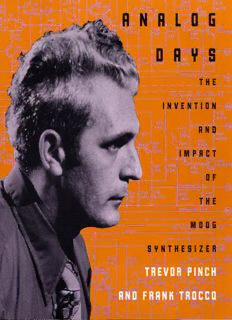
Analog Days: The Invention and Impact of the Moog Synthesizer PDF
Preview Analog Days: The Invention and Impact of the Moog Synthesizer
THE INVENTION AND IMPACT OF THE MOOG SYNTHESIZER Trevor Pinch and Frank Trocco HARVARD UNIVERSITY PRESS Cambridge, Massachusetts, and London, England ForAnnikaandBenika and ForEmmettandZaela Copyright©2002bythePresidentandFellowsofHarvardCollege all rights reserved PrintedintheUnitedStatesofAmerica FirstHarvardUniversityPresspaperbackedition,2004 LibraryofCongressCataloging-in-PublicationData Pinch,T.J.(TrevorJ.) Analogdays : theinventionandimpactoftheMoogsynthesizer / TrevorPinchandFrankTrocco, p. cm. Includesbibliographicalreferencesandindex. Discography:p. ISBN0-674-00889-8(cloth) ISBN0-674-01617-3(pbk.) 1.Moogsynthesizer. I.Trocco,Frank. II.Title. ML1092.P56 2002 786.7(cid:2)419—dc21 2002027257 Foreword robert moog usicalinstrumentdesign isoneofthemostsophis- M ticated and specialized technologies that we humans have developed. Even the drums and pipes of our distant ancestors were among the most highly developed artifacts of their time. More recently, bowed and reed instruments were assembled from unlikely combinations of materials, each of which was meticulously shaped as acomponent of a complex structure. Among products that matured in the industrial manu- facturing environment of the eighteenthand nineteenth centuries, the pi- anoandthesaxophoneareuniquebothintheingenuityoftheirdesignand the precision of their manufacturing processes. Thus, when we speak of musical instruments today, we understand that weare t alking about pre- ciselymadeandfinelytunedobjects. On the other hand, musical instrument design has always been at the fringeoftechnology,farfrommainstreampracticesthatstresseaseofman- ufacture, predictability, and economy. Materials such as the woods, glues, varnishes, and catgut of string instruments or the alloys used to make cymbals are selected for properties that defy objective specification; and component pieces, like the neck of a cello or the body ofa bassoon, a re contoured with organic complexity. Testing and adjustment are largely a matter of human judgment, rather than the application of rulers and gauges.Infact,someofthefinestmusicalinstrumentsaresospecialandid- iosyncraticthatnobodyhaseverlearnedhowtoreplicatethemexactly. Howcanitbethatmusicalinstrumentsarebothsophisticatedtechnolog- icaldevicesandquirkyartifactsthatoftenseemtoborderontheirrational? Ibelievethattheanswerliesinhowmusicalinstrumentsareused.Music- makingrequiresboththemusicianandthelistenertofunctionatthevery limits of their perceptive and cognitive capabilities. Therefore, amu sical instrument has to be as effective as possible in translating the musician’s gesturesintothesoniccontoursthatheisenvisioning.Whenheperforms, the musician feels his instrument respond ashe hears the sounds that it produces.Intermsofmoderninformationtheory,themusician-instrument system contains amultiplicity of complex feedback loops, so complex, in fact, that contemporary technology has so far not been able to analyze or characterize the nature of the instrument-musician interaction with preci- sion or completeness. Thus, it is not possible to design a musical instru- ment by beginning with an objective set of performance specifications. Rather, amu sical instrument design usually begins with a designer’s intu- ition.Insomemanner,thisintuitionsuggeststothedesignerthatacertain arrangementofmaterialswillresultinaninstrumentwithdesirablesound andresponsecharacteristics. Now we get to a tricky question: Where does the intuition come from? Does one attend amajor university to learn it, or study reference books? Doesonepickitupfromateacherormaster?Canyoudevelopitfromex- perience, just by experimenting? Howabout learning from one or more musician-collaborators? Are you perhaps born with it? The answer to all thesequestions,Ibelieve,is“Yes,tosomeextent.”Theyallmaycontribute, but no one source accounts for all the intuition you need to make good musical instruments. Well then, what else is there? I believe that ideas vi andconceptspermeateouruniverseandourconsciousness,formingwhat might be called a“cosmic network,” and some of us are adept at noticing themanddrawingonthem.ThisisnotsomethingyoulearnaboutinEngi- neering School. In fact, modern science is just now, through the work of the biologist Rupert Sheldrake and others, addressing the question of how FOREWORD someofusseemtobeawareofeventsatsomedistanceinspaceandtime. This can explain why technical innovations frequently seem to pop up si- multaneously in different places. As you read through this book, you will come across several clear examples of the phenomenon of “shared intu- ition.” Electronic musical instrument technology during the past century has developed through the contributions of many intuition-inspired innova- tions.Atthebeginning ofthetwentiethcentury,evenbeforetheinvention ofthevacuumtube,thepatentattorneyandinventorThaddeusCahillen- visioned amu sic production and distribution system in which tones were produced by 15-kilowatt electrical generators and distributed over wires similartotelephonelines.Withinvestors’backing,Cahillactuallyinstalled such a system in midtown Manhattan. Known as the telharmonium, his systemwasnotacommercialsuccess,butitdidforetellthedevelopmentof the Hammond organ, the electronic music synthesizer, and Muzak. Just a fewyearsaftertheintroductionofthetriodevacuumtube,LeonTheremin noticedthatwhistlesfromanimproperlyadjustedradiocouldbevariedby hand motion. From that, he proceeded to develop the space-controlled electronicmusicalinstrumentthatbearshisname.(Bytheway,Theremin wasalsothefirsttodevelopcolortelevision,duringthesameperiodthathe did his groundbreaking work with electronic musical instruments.) An- otherearlyvisionary,MauriceMartenot,usedcircuitrysimilartothatused by Theremin to design a strikingly innovative keyboard-controlled instru- ment. Throughout the 1930s and continuing after the Second World War, dozens upon dozens of innovators developed novel electronic musical in- strumentsofallsorts.Aselectronictechnologyhasitselfadvanced,thecos- micnetworkhasconstantlyhummedwithideasfornewdevicesthatmusi- vii cianscouldplay. Few of the early electronic music innovations such as the trautonium, the hellertion, the crea-tone, the oscillion, and the emiriton have become widelyaccepted.Incontrast,today’spopularmusicsimplywouldnotexist FOREWORD withoutthemusictechnologyofthepasthalfcenturyorso.Whyhavemost early electronic musical instruments fallen into obscurity, while many re- cent developments such as the keyboard synthesizer, the phaser, and the fuzz box have become part of the growing electronic musical instrument industry?Rapidlyevolvingelectronictechnologyisonlypartoftheanswer. Thecompleteanswermusttakeintoaccounttheevolutionofthecultural environment in which we are immersed. Just as a musician interacts with her instrument as her music evolves, technology and our culture are con- stantly interacting asthey themselves evolve. The stories in this book, of how synthesizers came into being, provide fascinating and revealing in- sights into how technical, commercial, and cultural trends shape one an- other.Inaddition,Ibelieveyouwillfindthatthestoriesalsoshedlighton the cosmic network, and how it contributes to human creativity and inno- vation. viii FOREWORD Contents Preface xi Introduction:SculptingSound 1 1. SubterraneanHomesickBlues 12 2. Buchla’sBox 32 3. ShapingtheSynthesizer 53 4. TheFunkyFactoryinTrumansburg 70 5. Haight-Ashbury’sPsychedelicSound 89 6. AnOddCoupleintheSummerofLove 107 7. Switched-OnBach 131 8. InLovewithaMachine 155 9. MusicofMyMind 171 10. Live! 187 11. Hard-Wired—theMinimoog 214 12. InventingtheMarket 237 13. CloseEncounterswiththeARP 257 14. FromDalekstotheDarkSideoftheMoon 276 Conclusion:Performance 302
Description: